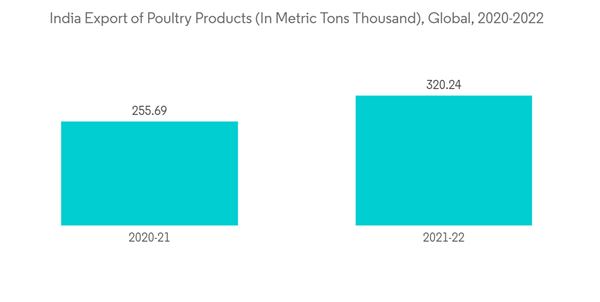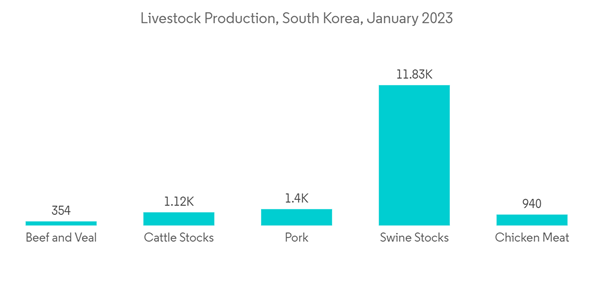The APAC Anticoccidial Drugs Market size is estimated at USD 390.12 million in 2024, and is expected to reach USD 495.29 million by 2029, growing at a CAGR of 4.89% during the forecast period (2024-2029).
Due to the COVID-19 outbreak, a short-term negative impact was seen on the market due to decreased visits to veterinary hospitals and clinics. Healthcare services were significantly reduced due to social distancing measures taken by governments across the globe. For instance, as per the data published by the National Institute of Health in March 2021, it was observed that pet adoption increased in Asian countries during the pandemic, and initial vaccinations on pets were done regularly. However, other than pets, the farm animal vaccination was not done at a given time due to the pandemic restrictions. Additionally, standard practices such as routine animal checkups, diagnoses, and surgeries were disrupted. These decreased services lowered the coccidiosis diagnosis. But, at the later stage of the pandemic, smart agriculture and livestock production systems with animal welfare aspects were adopted. For instance, according to an article published by Frontiers in Veterinary Science in January 2021, initiatives such as a national risk assessment, clear communication channels, contingency plans, a crisis response group, and support systems for animal care providers were taken by Australia for animal welfare. This initiative during the pandemic led to increased demand for diagnosing animal diseases, and market started to witnessed gradual growth.
Factors such as increasing incidence of coccidiosis and advancements in veterinary healthcare are expected to drive market growth over the forecast period. For instance, according to an article published by Veterinaria Digital S.A., in December 2021, humidity and temperature conditions in Southeast Asia are two critical factors for the development and survival of coccidia and its vector, the Alphitobius beetle. All of them promote high infectious pressure in indigenous chicken breeds. According to the above source, a prevalence of 65.83% and 68.5% of coccidia, respectively, was observed in Ben Tre and Hau Giang provinces. Such a high incidence of coccidiosis in the region is expected to increase the demand for anticoccidial drugs, thereby driving the market growth.
Moreover, Eimeria is a genus of apicomplexan parasites that includes various species capable of causing the disease coccidiosis in animals such as cattle, poultry, dogs, cats, and smaller ruminants, including sheep and goats. According to the research article published in August 2022, in Queensland, Australia, weaned cattle tend to be more affected in summer due to coccidiosis, possibly because of stress, and even if it can happen to a year-old cattle, clinical infection usually starts at 1-2 months of age because coccidiosis rarely manifests in the first three weeks of life. Thus, the burden of coccidiosis among the target animals of specific age demands the availability of the effective treatment which is expected to boosts the market growth over the forecast period.
However, the availability of alternative treatment options in the market is expected to hinder market growth over the forecast period.
Furthermore, according to a report published in September 2022 by the United States Department of Agriculture (USDA), poultry production in China is expected to remain stable at 14.3 million metric tons in 2023. Additionally, according to the above source, China's poultry exports are expected to increase by 5% in 2023. Thus, with increased poultry production, the chances of developing coccidiosis increase, thereby increasing the demand for anticoccidial drugs.
Thus, owing to the factors above, the studied market is expected to witness significant growth over the forecast period.
The country's veterinary regulatory organizations were compelled to establish national animal health insurance programs due to the increasing expenses of owning pets and paying for veterinary care. For instance, in October 2021, the Ministry of Agriculture, Food and Rural Affairs instructed to conduct a nationwide study in Korea to understand the expenses of veterinary care and treatments to introduce state-run health insurance for pets. Such initiatives are likely to boost the demand for anticoccidial drugs during the forecast period.
Thus, owing to the abovementioned factors, the studied market in South Korea is expected to witness significant growth over the forecast period.
This product will be delivered within 2 business days.
Due to the COVID-19 outbreak, a short-term negative impact was seen on the market due to decreased visits to veterinary hospitals and clinics. Healthcare services were significantly reduced due to social distancing measures taken by governments across the globe. For instance, as per the data published by the National Institute of Health in March 2021, it was observed that pet adoption increased in Asian countries during the pandemic, and initial vaccinations on pets were done regularly. However, other than pets, the farm animal vaccination was not done at a given time due to the pandemic restrictions. Additionally, standard practices such as routine animal checkups, diagnoses, and surgeries were disrupted. These decreased services lowered the coccidiosis diagnosis. But, at the later stage of the pandemic, smart agriculture and livestock production systems with animal welfare aspects were adopted. For instance, according to an article published by Frontiers in Veterinary Science in January 2021, initiatives such as a national risk assessment, clear communication channels, contingency plans, a crisis response group, and support systems for animal care providers were taken by Australia for animal welfare. This initiative during the pandemic led to increased demand for diagnosing animal diseases, and market started to witnessed gradual growth.
Factors such as increasing incidence of coccidiosis and advancements in veterinary healthcare are expected to drive market growth over the forecast period. For instance, according to an article published by Veterinaria Digital S.A., in December 2021, humidity and temperature conditions in Southeast Asia are two critical factors for the development and survival of coccidia and its vector, the Alphitobius beetle. All of them promote high infectious pressure in indigenous chicken breeds. According to the above source, a prevalence of 65.83% and 68.5% of coccidia, respectively, was observed in Ben Tre and Hau Giang provinces. Such a high incidence of coccidiosis in the region is expected to increase the demand for anticoccidial drugs, thereby driving the market growth.
Moreover, Eimeria is a genus of apicomplexan parasites that includes various species capable of causing the disease coccidiosis in animals such as cattle, poultry, dogs, cats, and smaller ruminants, including sheep and goats. According to the research article published in August 2022, in Queensland, Australia, weaned cattle tend to be more affected in summer due to coccidiosis, possibly because of stress, and even if it can happen to a year-old cattle, clinical infection usually starts at 1-2 months of age because coccidiosis rarely manifests in the first three weeks of life. Thus, the burden of coccidiosis among the target animals of specific age demands the availability of the effective treatment which is expected to boosts the market growth over the forecast period.
However, the availability of alternative treatment options in the market is expected to hinder market growth over the forecast period.
APAC Anticoccidial Drugs Market Trends
Poultry Segment is Expected to hold a Significant Share in the Anticoccidial Drugs Market Over The Forecast Period
Coccidiosis is a parasitic disease with a great impact on poultry farming due to the high percentage of morbidity. The increase in the poultry population and the high prevalence of coccidiosis in poultry drive market growth. For instance, according to an article published by Veterinaria Digital, in September 2022, coccidiosis in India is highly prevalent, especially in the monsoon season. It causes many economic losses in the poultry sector, with high mortality and marked by worsening production indices. Additionally, according to the above source, the prevalence of coccidiosis in broilers ranges between 5% and 70% depending on many factors, such as management, the presence of vectors such as Alphitobius, high temperature, and humidity conditions, among many others. Thus, the region's high prevalence of coccidiosis is expected to drive market growth over the forecast period.Furthermore, according to a report published in September 2022 by the United States Department of Agriculture (USDA), poultry production in China is expected to remain stable at 14.3 million metric tons in 2023. Additionally, according to the above source, China's poultry exports are expected to increase by 5% in 2023. Thus, with increased poultry production, the chances of developing coccidiosis increase, thereby increasing the demand for anticoccidial drugs.
Thus, owing to the factors above, the studied market is expected to witness significant growth over the forecast period.
South Korea is Expected to Dominate the Asia-Pacific Anticoccidial Drugs Market Over the Forecast Period
The major factors attributed to the market growth in South Korea are the rising animal population and animal expenditure, along with the growing burden of coccidiosis in the country. Besides, the country is actively involved in initiatives like research surveys and diagnostics to promote good pet health and awareness about pet diseases. For instance, the 2021 open survey of Pet Trends Report stated that in 2020, 73% of millennial pet owners prioritized pets' well-being by spending out-of-pocket. Additionally, according to the above report, medical treatment, insurance, and pet hotels were chosen as the top 3 features pet owners wanted to see growth in. According to the survey, between 2020 and 2021, a pet owner spent, on average, around USD 450 on veterinary care. Hence, pet owners' priority for their pet well-being is expected to drive market growth in South Korea over the forecast period.The country's veterinary regulatory organizations were compelled to establish national animal health insurance programs due to the increasing expenses of owning pets and paying for veterinary care. For instance, in October 2021, the Ministry of Agriculture, Food and Rural Affairs instructed to conduct a nationwide study in Korea to understand the expenses of veterinary care and treatments to introduce state-run health insurance for pets. Such initiatives are likely to boost the demand for anticoccidial drugs during the forecast period.
Thus, owing to the abovementioned factors, the studied market in South Korea is expected to witness significant growth over the forecast period.
APAC Anticoccidial Drugs Industry Overview
The Asia-Pacific anticoccidial market is moderately concentrated in nature due to the presence of companies operating globally and regionally. The competitive landscape includes an analysis of local companies which hold market shares and are well known, including Boehringer Ingelheim, Elanco Animal Health, Merck, Virbac, Vetoquinol SA, and Zoetis Animal Healthcare, among others.Additional Benefits:
- The market estimate (ME) sheet in Excel format
- 3 months of analyst support
This product will be delivered within 2 business days.
Table of Contents
1 INTRODUCTION
4 MARKET DYNAMICS
5 MARKET SEGMENTATION (Market Size by Value - USD million)
6 COMPETITIVE LANDSCAPE
Companies Mentioned (Partial List)
A selection of companies mentioned in this report includes, but is not limited to:
- Elanco
- Vetoquinol SA
- Huvepharma
- Virbac
- Zoetis Animal Healthcare
- MSD Animal Health
- Boehringer Ingelheim International GmbH
- Ceva Animal Health Inc
- Novartis AG
- Impextraco NV
- Huvepharma
Methodology

LOADING...










